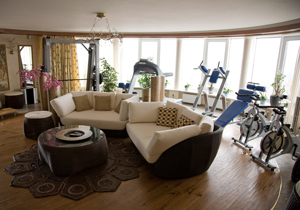 If there is no gym near you, or if you would prefer the privacy of your own space, you can always exercise at home.
If there is no gym near you, or if you would prefer the privacy of your own space, you can always exercise at home.
There are many exercises that you can do with basic inexpensive equipment – or even use household objects instead.
Some exercises only require your own body weight (these are often referred to as calisthenic exercises).
Basic calisthenic exercises – no equipment required
- Upper body exercises: press-ups, dips
- Lower body exercises: lunges, squats, calf-raises
- Full body exercises: burpee
- Core exercises: sit-ups, crunches
- Cardio exercises: jumping jacks
Using household objects as equipment
Dumbbells substitute. You can start by using tins or cans of foods as dumbbells – a typical one will be about 0.5kg. Once this gets easy (which will probably happen quickly), you can try filling empty water bottles or milk bottles with sand or gravel, and measure the weight using your kitchen or bathroom scales. Another option is to use glass jars and fill them with pennies – choose a jar with an indent in the middle so you can grip it easily.
Barbell substitute. Barbell is harder to replicate at home than dumbbells, as it tends to be heavier so it is more important to have the correct shape that allows even distribution of the weight. One option you can try is a backpack filled with heavy objects – anything at all. For example, you could use books and add some clothes or towels to ensure they don’t bob about as you move. You can perform squats, lunges and press-ups with the backpack.
Please note these options will only take you so far. Once you build up your strength, you will need to think about investing in proper equipment, to ensure correct technique and minimise the possibility of injuries.
Fitness equipment for home
If you do have some budget to spend on fitness equipment for home, there are many inexpensive options that are reasonably compact but will allow you to perform a full range of exercises.
- Dumbbells – you can either buy some fixed weight dumbbells, or just get dumbbell handlebars, collars and a selection of weights, so you can make up whichever weight is required. The latter option is likely to be more expensive, but be more effective in the long term run as you can keep adding more weight to it.
- Barbell – many basic weightlifting exercises are performed using a barbell. You can start from using an empty bar (standard weights are 13kg, 15kg and 20kg for a full size Olympic bar) and buy more weight plates gradually as your strength develops. This can work particularly well if you also use dumbbells, as you can use the same set of weight plates for both (ensure the diameters of bars and weight plates match when buying).
- Step – step can useful both for cardio workouts (step aerobics) and strength exercises – use it as a bench or a platform to increase your range of motion.
- Skipping rope – skipping is a great cardio workout which you can do anywhere, as long as you have about a square meter of space.
- Resistance bands – you can attach these elastic bands to a doorframe or a heavy object such as a sofa, and perform pulling exercises
- Swiss ball – you can use the ball for a wide range of flexibility and core exercises. Sitting on a Swiss ball instead of a chair for prolonged periods can help to strengthen your mid-section and posture.
Strength exercises – Correct technique
Correct technique is crucial when doing strength exercises, and it becomes more and more important as your strength develops. The heavier the weights you lift, the higher the risk of injury. The best way to learn correct technique is to get a face-to-face consultation from en expert – a personal trainer or an instructor in your local gym. Perhaps you have a friend who has a lot of experience in lifting.
If no face-to-face consultations are possible, please do spend some time learning about correct techniques online. There are thousands of videos on YouTube and articles that tell you how to do it properly. Any time spent learning will be time well-spent, as bad technique can hinder your progress and cause injuries.
Home fitness videos
Many celebrity trainers publish their own fitness programmes, often with video-recorded instructions that you can replicate at home.